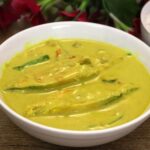Goan Caldin Curry Recipe
Goan Caldin Curry, also known as Caldinho, is a mild, coconut-based curry often made with fish, prawns, or pomfret. This versatile dish is from Goa’s coastal cuisine, perfect for those who love light, flavorful curries. Learn to make it with step by step photos and a quick video tutorial.
Servings: 4 servings
Calories: 308kcal
Equipment
- 1 medium size mixing bowl
- 1 Strainer or muslin cloth
- 1 Mixer/Blender Jar
- 1 Heavy bottom pan
Ingredients
To marinate the fish
- 2 Pomfret fish, (also called Paplet) (500 grams)
- ½ teaspoon salt
- 1 teaspoon turmeric
Caldin Masala
- 2 cups coconut 1 whole coconut, scraped
- 1.5 tablespoon coriander seeds
- 1 teaspoon cumin
- 25 peppercorns
- 4-6 cloves
- 1- inch ginger
- 6 garlic cloves big size, if using small size garlic - add 12 garlic cloves
- 1 teaspoon turmeric
- 4 green chilies spicy, add as per taste
Caldin curry
- 2-3 teaspoon oil
- 2 onions chopped
- 1 tomato chopped
- 1 green chili
- salt to taste
- 1 teaspoon sugar
- ½ lemon size ball of tamarind (Soak it in hot water for 15 minutes)
Instructions
Preparations to make Fish Caldine
- Marinate the fish: Marinate the fish with salt and turmeric, ensuring it's evenly coated. Set aside. Also, soak the tamarind in hot water for 15 minutes. Set aside.
- Preparing first coconut extract: In a blender, combine coconut, coriander seeds, cumin, peppercorns, cloves, ginger, garlic, turmeric, and green chilies. Add 1.5 cups of water and blend to a smooth paste. Strain the mixture to extract the first coconut milk. This is thick and creamier. Always added towards end of cooking the curry. Set aside.
- Second coconut milk extract: Return the remaining coconut mixture to the blender. Add 1 cup of water and blend again to a smooth paste. Strain the mixture in a separate bowl, to extract the second coconut milk. This is thin coconut milk and is used for cooking the curry. Set aside.
- Third coconut milk extract: This step is optional. You can proceed to the next step after the second extract. Return the remaining mixture to the blender. Add ½ cup of water and blend again. This is the third extract (thinnest). Strain it into the same bowl (used for second extract).
- Squeeze the soaked tamarind to extract the pulp, and strain it.
Making Goan Caldine Curry
- Heat 2-3 teaspoons of oil over medium heat. Add the onions and sauté until golden brown. Add the tomatoes and sauté until they soften and become pulpy. Lower the heat. Add the second and third strained coconut milk extracts. Stir and cook for 2 minutes.
- Add the tamarind pulp, salt, and green chili (optional). Add more green chilies if you prefer a spicier curry. Increase the heat to medium and bring the mixture to a boil, stirring to combine.
- Gently add the marinated fish. Do not stir. Hold the pan handles firmly and rotate the pan to combine. If your pan doesn't have handles, use a cloth to hold the sides of your pan/pot and rotate.
- Add 1 teaspoon of sugar and bring the curry back to a boil. Reduce the heat to low. Add the first coconut milk extract. Cook for 1-2 minutes on low heat until heated though. Do not boil after adding the first extract, as high heat can cause the coconut milk to split giving grainy texture to the curry. Fish caldin is ready to serve. It's a delicious, creamy curry with a mild flavor. I like to serve the Pomfret caldine with rice.
Video
Notes
- Use fresh coconut milk: I like to use freshly extracted coconut milk gives the best Caldin flavor. If you are using canned coconut milk then go for full-fat coconut milk.
- Don’t overcook the fish: Pomfret cooks quickly, so add it towards the end to keep it tender.
- Adjust spice levels: While Caldin is a mild curry, you can add extra green chilies or peppercorns for heat.
- Do not add extra green chilies while grinding the masala, or the curry may develop a slight green color. Better to slit the chilies and add them while sautéing the onions. I made this mistake while making the curry first time.
- Cooking with fresh coconut milk: Third & second coconut milk extracts are added first. This helps build flavor without making the curry too rich too soon. You can boil this extract. The first (thick) extract is at the end. Lower the heat and let it simmer gently.
- Boiling can cause the first coconut milk extract to separate, making the curry look grainy.
- Storing and Reheating:
- Storing: Store the leftover Caldin within 2 hours of cooking. Transfer it to an airtight container and refrigerate. It stays good for 2 days. Not a freezer-friendly recipe. Sometimes coconut milk can separate once you thaw it and reheat.
- Reheating: Warm the curry gently on low heat, stirring occasionally. Add a splash of water or coconut milk if the curry thickens too much.
- Read our full nutrition disclaimer here.
Nutrition
Serving: 1g | Calories: 308kcal | Carbohydrates: 22g | Protein: 24g | Fat: 15g | Saturated Fat: 9g | Cholesterol: 52mg | Sodium: 980mg | Potassium: 362mg | Fiber: 7g | Sugar: 8g | Vitamin A: 268IU | Vitamin C: 18mg | Calcium: 304mg | Iron: 3mg
